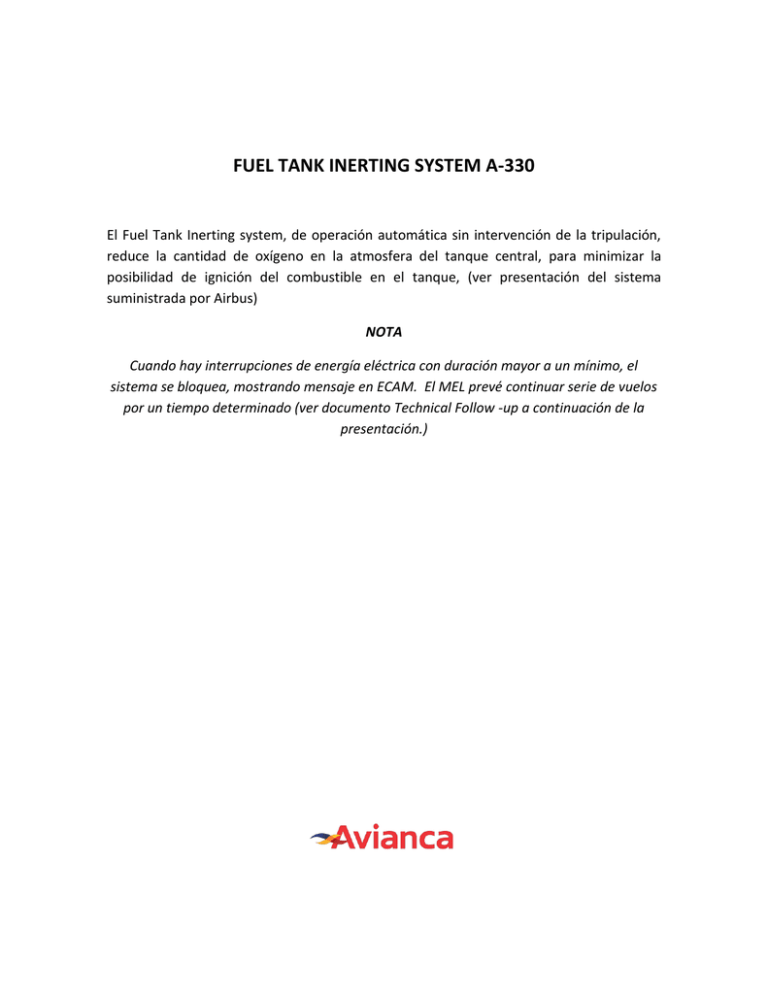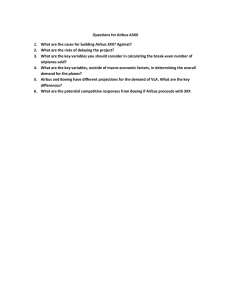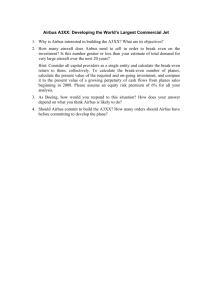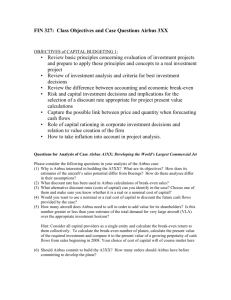
FUEL TANK INERTING SYSTEM A-330
El Fuel Tank Inerting system, de operación automática sin intervención de la tripulación,
reduce la cantidad de oxígeno en la atmosfera del tanque central, para minimizar la
posibilidad de ignición del combustible en el tanque, (ver presentación del sistema
suministrada por Airbus)
NOTA
Cuando hay interrupciones de energía eléctrica con duración mayor a un mínimo, el
sistema se bloquea, mostrando mensaje en ECAM. El MEL prevé continuar serie de vuelos
por un tiempo determinado (ver documento Technical Follow -up a continuación de la
presentación.)
Training session
February 2011
Presented by
Michel MESNIER (FSM AVABOG)
And
Nicolas KOQUELY (FSR AVABOG)
Fuel Tank Inerting System
ATA 47 and 21-58
Contents
• Part 1- Historical – Why this new System?
• Part 2 – System Description
© AIRBUS S.A.S. All rights reserved. Confidential and proprietary document.
• Part 3 – System Operation/Control
• Part 4 – Documentation
February 2011
Page 2
© AIRBUS S.A.S. All rights reserved. Confidential and proprietary document.
Historical
Part 1 - Why This New System?
February 2011
Page 3
Why a new system?
• In 1996, a TWA B747 exploded after take-off due to a suspected spark
in the centre tank combined with little amount of fuel in this tank which
had been heating on ground, and generating fuel vapours.
• As a result, the Federal Aviation Authority (FAA) undertook researches
into fuel tank flammability
© AIRBUS S.A.S. All rights reserved. Confidential and proprietary document.
• The FAA and EASA have now released new rules in order to reduce
the flammability of aircraft fuel tanks.
Flammability Reduction System also called Fuel Tank Inerting System
Ignition risks addressed in SFAR88 rules.
February 2011
Page 4
© AIRBUS S.A.S. All rights reserved. Confidential and proprietary document.
System Description
Part 2 - SYSTEM DESCRIPTION
February 2011
Page 5
System Description
The architecture is broken down in two major subsystems:
The Conditioned Service Air System (CSAS) ATA 21-58
The Conditioned Service Air System (CSAS) is an air temperature conditioning system.
The CSAS cools the hot engine bleed air and supplies the conditioned air to the Inert
Gas Generation System (IGGS) . The CSAS controller is the primary computer which
controls this system. The controller operates the valves, monitors air temperature and air
pressure to supply the necessary flow of conditioned air to the inert gas generation
system.
© AIRBUS S.A.S. All rights reserved. Confidential and proprietary document.
The Inert Gas Generation System (IGGS) ATA 47
The IGGS is composed of an Air Separation Module (ASM). ASM’s filter oxygen
molecules, from the air supply provided by the CSAS. The oxygen molecules are vented
overboard, as Oxygen Enriched Air, through the ASM OEA port. The ASM output air is
composed of NEA, which is supplied to the fuel tank to inert the tank. The IGGS uses
hollow permeable membrane fibers, packaged as Air Separation Modules (ASM), to
remove oxygen from a compressed air stream, thus creating nitrogen enriched air
(NEA).
February 2011
Page 6
© AIRBUS S.A.S. All rights reserved. Confidential and proprietary document.
System Description
February 2011
Page 7
© AIRBUS S.A.S. All rights reserved. Confidential and proprietary document.
CSAS Part
February 2011
Page 8
© AIRBUS S.A.S. All rights reserved. Confidential and proprietary document.
IGGS Part
February 2011
Page 9
© AIRBUS S.A.S. All rights reserved. Confidential and proprietary document.
FTIS location on SA A/C
February 2011
Page 10
© AIRBUS S.A.S. All rights reserved. Confidential and proprietary document.
FTIS location on LR A/C
February 2011
Page 11
© AIRBUS S.A.S. All rights reserved. Confidential and proprietary document.
System Operation
Part 3 – System Operation/Control
February 2011
Page 12
© AIRBUS S.A.S. All rights reserved. Confidential and proprietary document.
CSAC Schematic
February 2011
Page 13
FTIS Operation CSAS Part (ATA 21-58)
• The Conditioned Service Air System (CSAS) operates only during flight conditions and it
stops the operation of the system when the aircraft is on ground.
• The CSAS controller is the primary computer which controls this system. The controller
operates the valves, monitors air temperature and air pressure to supply the necessary
flow of conditioned air to the inert gas generation system.
• The CSAS gets hot compressed air (bleed air) from the pneumatic air distribution
© AIRBUS S.A.S. All rights reserved. Confidential and proprietary document.
system. This hot bleed air comes from the manifold near the high pressure ground
connector and flows through the CSAS isolation valve to an ozone converter. The CSAS
isolation valve controls the airflow in the system.
• A hot air bypass valve is installed in the bypass duct. The hot air bypass valve adds hot
bleed air to the always cold air downstream of the heat exchanger to increase the
temperature.
February 2011
Page 14
FTIS Operation CSAS Part (ATA 21-58)
• A temperature sensor and a pressure sensor, which are installed in the duct to the Inert
Gas Generation System (IGGS), monitor the conditioned air and transmit the signals to
the CSAS controller.
• The CSAS controller receives the data, compares them to the demand from the IGGS
controller and, if necessary, operates the valves.
• In case of pack 1 inoperative, the FTIS will not be operative but will not generate a
© AIRBUS S.A.S. All rights reserved. Confidential and proprietary document.
Maintenance message at the cockpit, so no FTIS MEL entry is required.
February 2011
Page 15
© AIRBUS S.A.S. All rights reserved. Confidential and proprietary document.
IGGS Schematic
February 2011
Page 16
FTIS Operation IGGS part (ATA 47)
• A Gate Valve (GV), Temperature Sensor (T2) and Pressure Sensor (P2) are located on
the input to the IGGS, to insure proper air temperature and pressure is maintained to the
ASM input.
• Between the GV and T2, a Double Ultra Low Particulate Air (DULPA) is used to remove
any particles from the IGGS input air supply, prior to the ASM inlet.
• An Oxygen Sensor samples the ASM output air to measure and insure the correct NEA
concentration is being provided to the fuel tank. The O2 Sensor also provides a pressure
reading during the health monitoring sequence.
© AIRBUS S.A.S. All rights reserved. Confidential and proprietary document.
• Downstream of the O2 sensor, the Dual Flow ShutOff Valve (DFSOV) controls the flow
of NEA to the fuel tank during Fuel Tank Inert System (FTIS) operation. The DFSOV is
open when the FTIS is operating and closed if the FTIS is off. The DFSOV helps prevent
backflow of fuel or fuel fumes, whenever the FTIS is not operating.
February 2011
Page 17
FTIS Operation IGGS part (ATA 47)
• Downstream of the DFSOV, a Dual Flapper Check Valve installed in the NEA duct for
additional protection from fuel/vapor ingress into the FTIS. The DFCV is situated in the
NEA distribution line and installed above the entrance to the fuel tank and assembled to
the In-Tank Housing which is installed inside the fuel tank.
• NEA flow provides the muscle pressure to open both check valves and the DFSOV.
Without NEA flow, the two check valves of DFCV and the DFSOV maintain a normally
closed position, forming a triple barrier against fuel/vapor backflow into the IGGS.
• The IGGS Controller provide the necessary output signals used to control airflow and
© AIRBUS S.A.S. All rights reserved. Confidential and proprietary document.
shutdown the IGGS, if a failure is detected.
February 2011
Page 18
© AIRBUS S.A.S. All rights reserved. Confidential and proprietary document.
FTIS operative conditions
The FTIS will be operative when the following conditions are
met:
BLEED AIR AVAILABLE = True
And Weight on Wheels (WOW) = false
And ECS COMMANDED OFF = false
And No digital latch is set (No Volatile Memory latch not
set).
And IGGS TOTAL AVERAGE AIR TEMPERATURE <=
47°C.
And ENG1_FIRE = no fire
→ At landing, FTIS will be switched off
February 2011
Page 19
FTIS Control/Indicating
• The FTIS is controlled and monitored by a combination of two communicating controllers
with digital monitoring and analog partitioning: one for the CSAS portion of the system
and one for the IGGS portion.
• The IGGS Controller Unit (ICU) is the automatic controlling and monitoring unit of the
IGGS. The controllers provide automatic control of the FTIS without pilot interaction.
• Primary functions include: monitoring LRU health, provide CSAS temperature control,
© AIRBUS S.A.S. All rights reserved. Confidential and proprietary document.
switch from low to high flow during descent, provide over-temperature protection and
provide over-pressure protection.
• The controllers will provide a means of shutting down the FTIS when a critical fault is
detected. For each controller, a critical fault detected by either section (digital or
analogue) causes a fault to be logged to the other section.
February 2011
Page 20
FTIS Control/Indicating (continued)
• The digital latched fault can be cleared by a successful maintenance activity conducted
by means of the maintenance computer, CMC (Centralized Maintenance Computer).
• The FTIS will not operate during refueling or de-fueling operations in order to protect the
aircraft from potential fuel tank over pressurization.
• The FTIS remains on and in the low-flow mode during: takeoff, climb and cruise.
© AIRBUS S.A.S. All rights reserved. Confidential and proprietary document.
• After cruise the airplane begins descent and the IGGS is switched to the high flow mode.
The high-flow mode maximizes the volume of NEA entering the fuel tank, which curbs
the amount of vent inflow. During descent the ambient pressure continuously increases,
which causes the vent pressure to increase and outside air to enter the fuel tanks.
Increasing the NEA flow rate reduces the amount of outside air entering the tank and
also increases the NEA oxygen concentration. The goal is to optimize the balance
between the NEA oxygen concentration, NEA flow rate, and the amount of outside air
entering the tank so that at the end of descent, the average fuel tank oxygen
concentration is near or below 11%. Immediately after landing the FTIS is commanded
off.
February 2011
Page 21
FTIS Bite
• The BITE functionality of the IGGS is hosted in the CSAS controller, except a
memorization function and a pre-consolidation of faults.
• Initial Test at Power up and Start Up. During IGGS operation, a Continuous BITE will
check IGGS equipment and transmit fault messages to FWC and Maintenance
computer.
© AIRBUS S.A.S. All rights reserved. Confidential and proprietary document.
• Interactive BITE Test with Bleed Pressure for FTIS Health Check: This test would be run
with a bleed source available at the inlet of the CSAS. This bleed source could be APU
or a high-pressure ground cart. This test will check: Controllers, CSAS and IGGS
applications, Wiring, Sensors, Valves Open/closed functionality, External / internal
communication, System Functionality.
• Interactive BITE Test without Bleed will be used to check electrical component
connections within the FTIS system. This test will check: Controllers, CSAS and IGGS
applications, Wiring, Sensors, Valves position, External / internal communication.
February 2011
Page 22
Inerting menu in the MCDU
1. On the MCDU, select the
Maintenance Page
& select SYSTEM
REPORT/TEST
© AIRBUS S.A.S. All rights reserved. Confidential and proprietary document.
2. Select the second page
of the menu
3. Select the INERTING
menu
INERTING menu
February 2011
Page 23
© AIRBUS S.A.S. All rights reserved. Confidential and proprietary document.
Specific data
In this example Specific data allow to identify
failure of P2 IGGS pressure sensor .
February 2011
Page 24
© AIRBUS S.A.S. All rights reserved. Confidential and proprietary document.
Documentation
February 2011
Page 25
Documentation
• FCOM:
Description in FCOM 1.28.10
On Long Range aircraft, the failure of the Inerting system is covered by the crew
awareness: “ FUEL INERTING SYS FAULT” and is already included in the
FCOM 3.02.28 page 5 SEQ 303.
• MEL :
FAA 20 days non-renewable / EASA 10 days renewable once
No maintenance/Pilot action associated to MEL
© AIRBUS S.A.S. All rights reserved. Confidential and proprietary document.
• WBM:
FTIS has no specific impact on the SA and LR WBMs other than modifying the
global aircraft weight and CG.
February 2011
Page 26
© AIRBUS S.A.S. All rights reserved. Confidential and proprietary document.
MEL Item
February 2011
Page 27
© AIRBUS S.A.S. All rights reserved. Confidential and proprietary document.
MEL Item
February 2011
Page 28
© AIRBUS S.A.S. All rights reserved. Confidential and
proprietary document.
This document and all information contained herein is the sole
property of AIRBUS S.A.S.. No intellectual property rights are
granted by the delivery of this document or the disclosure of
its content. This document shall not be reproduced or
disclosed to a third party without the express written consent
of AIRBUS S.A.S. This document and its content shall not be
used for any purpose other than that for which it is supplied.
The statements made herein do not constitute an offer. They
are based on the mentioned assumptions and are expressed
in good faith. Where the supporting grounds for these
statements are not shown, AIRBUS S.A.S. will be pleased to
explain the basis thereof.
© AIRBUS S.A.S. All rights reserved. Confidential and proprietary document.
AIRBUS, its logo, A300, A310, A318, A319, A320, A321,
A330, A340, A350, A380, A400M are registered trademarks.
February 2011
Page 29
Technical Follow-Up
PAGE 1/2
TFU REF : 21.58.00.001
OWNER/EXT : C.AMSELLEM
Tel : +33 567197340
E-Mail : claire.amsellem@airbus.com
LR - Fuel Tank Inerting System issues
A/C Affected
: A330
Engine Affected :
DESCRIPTION :
The following issues have been reported from the field:
. Case 1 : ECAM message FUEL INERTING SYS FAULT + Class1 fault message FCMC1(5QM1)+FCMC2(5QM2)
The message is triggered at A/C power-up or if FCMC1 and 2 are reset, due to a power-up sequence of the ICU
compared to the FCMC. The message display is latched even if ICU FCMC communication is recovered at end of
power-up sequence.
. Case 2: Class1 fault message SDAC1(1WV1)/CSAS CTL UNIT(100HH) with no ECAM message
The message is triggered at A/C power-up sequence, and display is latched even if SDAC-CCU communication is
recovered at end of power-up sequence.
TFU STATUS : OPEN
TFU ISSUE DATE
TFU FIRST ISSUE DATE
TFU NEXT ISSUE DATE
ISSUE NB
:
:
:
:
MAR 2011
FEB 2011
APR 2011
03
IMPACTS CLASSIFICATION
Impact on
Impact on
Impact on
Impact on
Effect on
Category
Impact on
flight OPS
line maintenance
shop maintenance
environment
flight
PAX comfort
:
:
:
:
:
:
:
None
Low
None
None
None
None
RELEVANT DOCUMENTATION
Airbus OPS documentation
. Case 3 : ECAM message FUEL INERTING SYS FAULT + Class1 fault message CSAS ISOL VLV (111HH)
This message is triggered in case of loss of air engine bleed system 1 (AIR ENG1 BLEED FAULT at cockpit). The
FTIS is then shutdown and latched.
Airbus Maintenance documentation
It is to be noted that display of ECAM message FUEL INERTING SYSTEM FAULT is inhibited:
- in all phases except for flight phases 1 & 10
- and if DC1 Power is unavailable, or ADIRU1 or 3 is unavailable, or FCMC1&2 are unavailable or SDAC1 is
unavailable
VENDOR and PN affected
CONSEQUENCE :
. Case 1: The ECAM message is latched until T/S is done, even if FTIS remains operative. TSM 47-11-00-810-815-A
refers.
. Case 2: No ECAM message is generated and the system remains fully operational. No maintenance action is
necessary (neither interactive BITE test)
. Case 3: The ECAM message and System shut-down are latched until T/S is performed. TSM 21-58-00-810-802-A
should be followed to clear message and recover system operation.
Aircraft can be dispatched with no need for immediate maintenance action as per MMEL entry for ATA47
(note: MMEL coverage is 20 days for FAA and 10+10 for EASA)
INVESTIGATION STATUS :
. Case 1: Root cause is a timing & confirmation time discrepancy at power-up between FCMC and CCU.
. Case 2: Root cause is a timing & confirmation time discrepancy at power-up between SDAC and CCU
Other documentation
SERVICE BULLETIN
Airbus
Vendor
VENDOR and PN solution
Technical Follow-Up
PAGE 2/2
TFU REF : 21.58.00.001
OWNER/EXT : C.AMSELLEM
Tel : +33 567197340
E-Mail : claire.amsellem@airbus.com
LR - Fuel Tank Inerting System issues
A/C Affected
: A330
Engine Affected :
. Case 3: In case of AIR ENG1 BLEED FAULT, pilot must select BLEED1 P/B OFF and then X-Bleed valve Open. This
is to ensure continued air supply, including to FTIS. During this sequence the confirmation time for no bleed air to
FTIS is 3 seconds, with CSAS Isolation Valve closure. This scenario is valid only for RR engine only. On GE & RR
engines the level of pressure is high enough to provide time for X-Bleed valve opening before CIV closure.
MITIGATION / INTERIM PLAN :
. Case 1 : In the case these ECAM Warning & Fault Message are seen during A/C power-up or FCMC reset or FCMC
change over, TSM 47-11-00-810-815-A must be followed. This task first requires an iBite of the system without
bleed (AMM 47-31-34-740-801), that would then clear the messages.
As an alternative solution to the interactive BITE, these ECAM Warning & Fault Message can be cleared by CSAS Control
Unit (CCU )reset via C/B 11HH
. Case 2 : No maintenance action is necessary (neither interactive BITE test), since no ECAM Warning is latched
and system operation is maintained.
. Case 3 : as per TSM 21-58-00-810-802-A; perform I-bite with Bleed (AMM 21-58-00-710-803) would correct system
fault.
In addition AIR ENG1 BLEED FAULT must be corrected as per relevant TSM task depending on associated fault
message.
Note : If aircraft is dispatched with engine bleed system #1 considered inoperative as per ATA36 MMEL, FTIS
operation is not impacted.
MAINTENANCE ADVICE :
Case 1 : Apply TSM 47-11-00-810-815-A after aircraft power-up if ECAM message is triggered.
Case 2 : None
Case 3 : Apply TSM 21-58-00-810-802-A after flight if ECAM message is triggered.
OPS ADVICE :
N/A
REPERCUSSION ON A/C DISPATCH :
Please refer to Maintenance recommendations for T/S, or MMEL ATA47 for dispatch with FTIS system considered
inoperative.
PERMANENT OR FINAL SOLUTION :
All cases : The final solution will be determined by investigation outcomes.
TFU STATUS : OPEN
TFU ISSUE DATE
TFU FIRST ISSUE DATE
TFU NEXT ISSUE DATE
ISSUE NB
:
:
:
:
MAR 2011
FEB 2011
APR 2011
03





